Built-up Area Change Analysis in Hanoi Using Support Vector Machine Classification of Landsat Multi-Temporal Image Stacks and Population Data
Abstract
:1. Introduction
2. Historical Overview of the Study Area

3. Methods
3.1. Remote Sensing of Built-up Areas

3.2. Rural-Urban Gradient Analysis
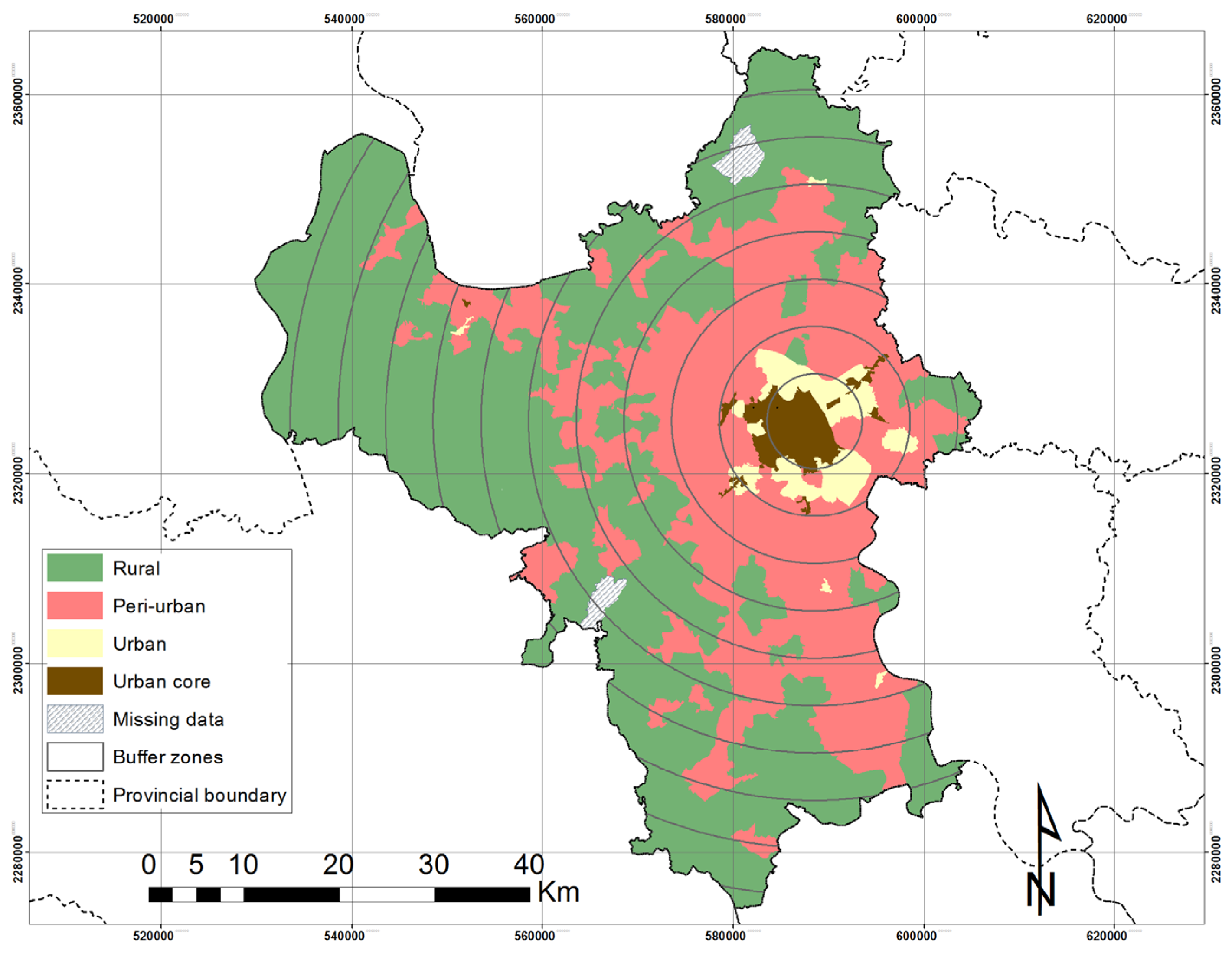
4. Results and Discussion
4.1. Land Cover Classification

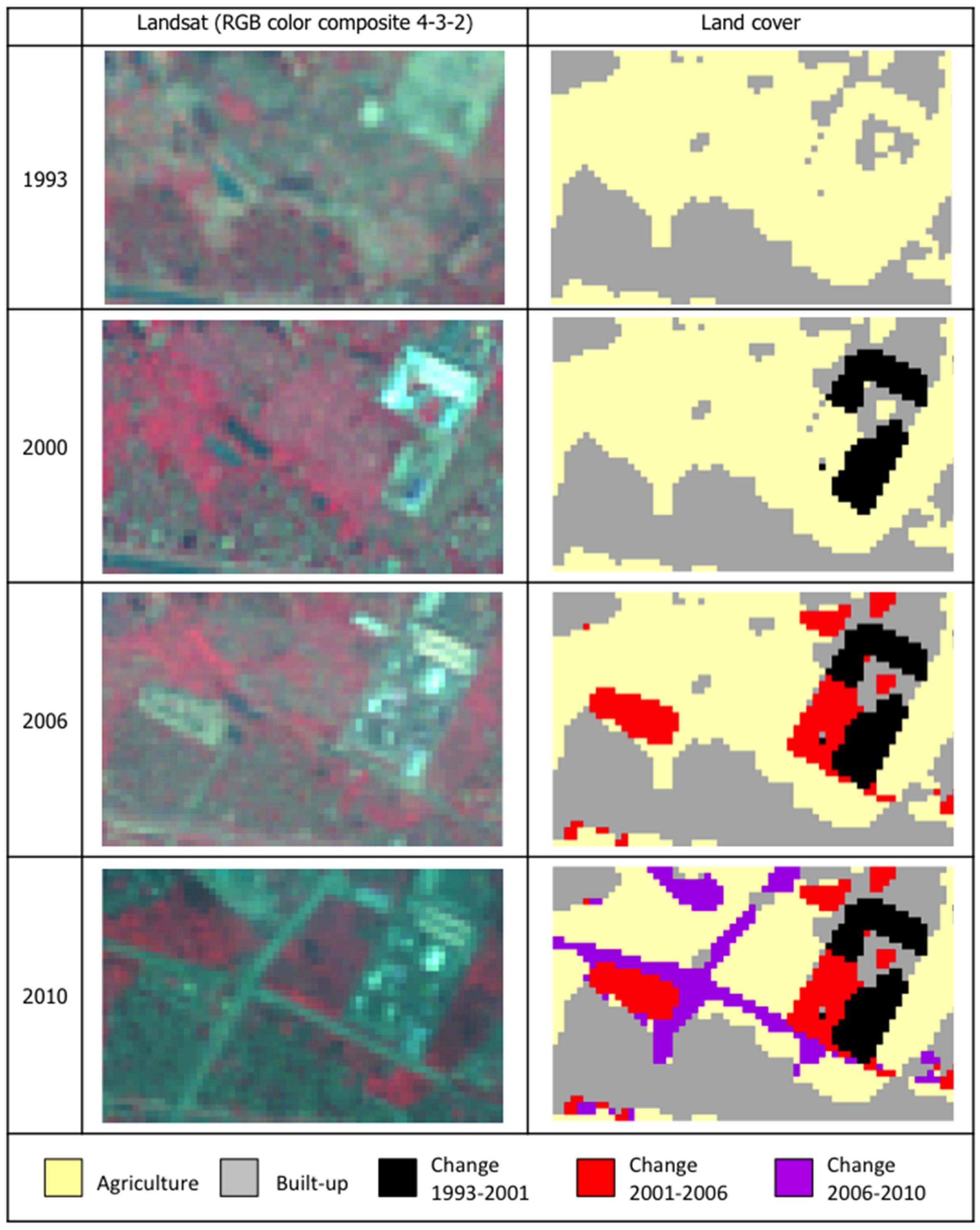
| Land Cover Classes | Producer’s Accuracy | User’s Accuracy |
|---|---|---|
| Agriculture | 95.60% | 95.11% |
| Built–up | 95.34% | 95.12% |
| Change 1993–2001 | 94.10% | 93.86% |
| Change 2001–2006 | 93.01% | 93.15% |
| Change 2006–2010 | 92.86% | 92.85% |
| Forest | 94.61% | 95.61% |
| Water | 94.90% | 95.38% |
| Overall Accuracy | 94.5% | |
| Kappa Coefficient | 0.93 | |
4.2. Gradient Analysis of Newly Built-Up Areas in Hanoi
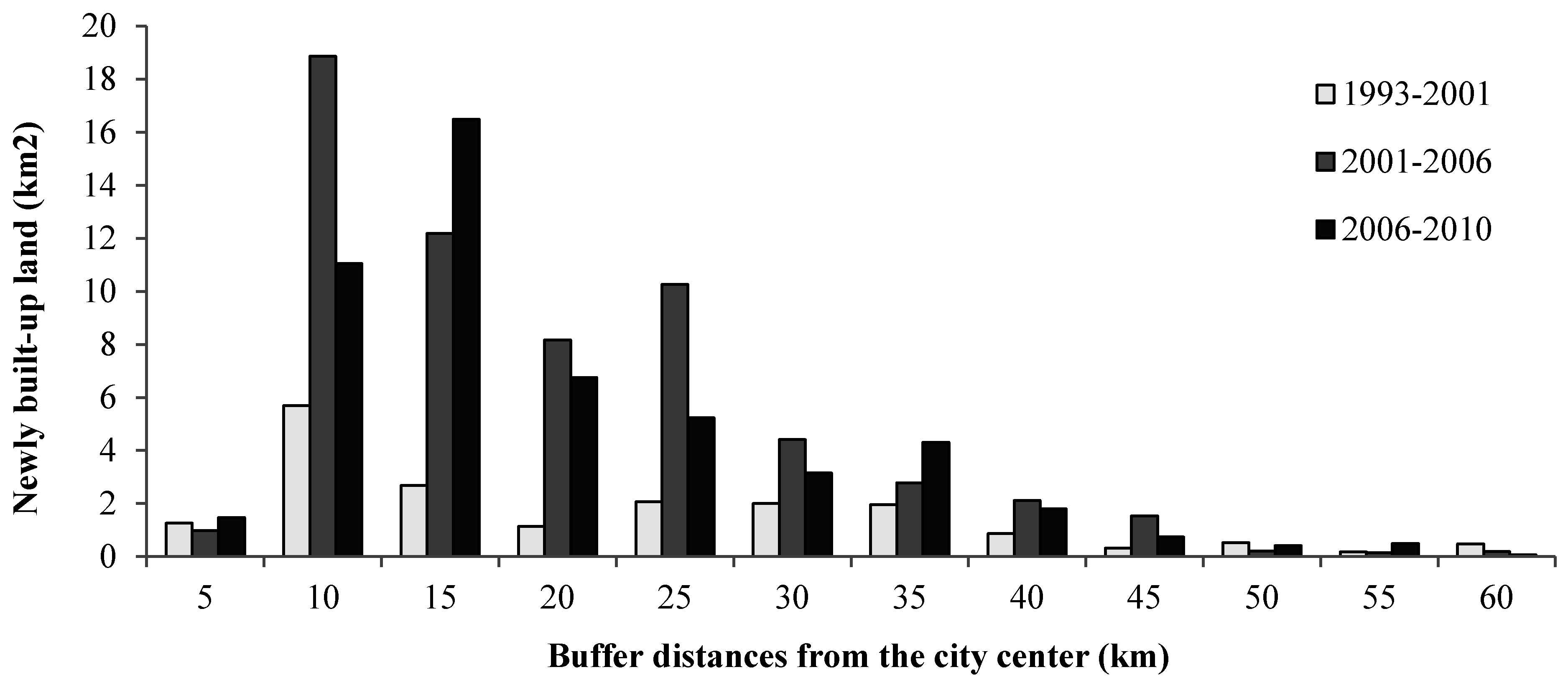
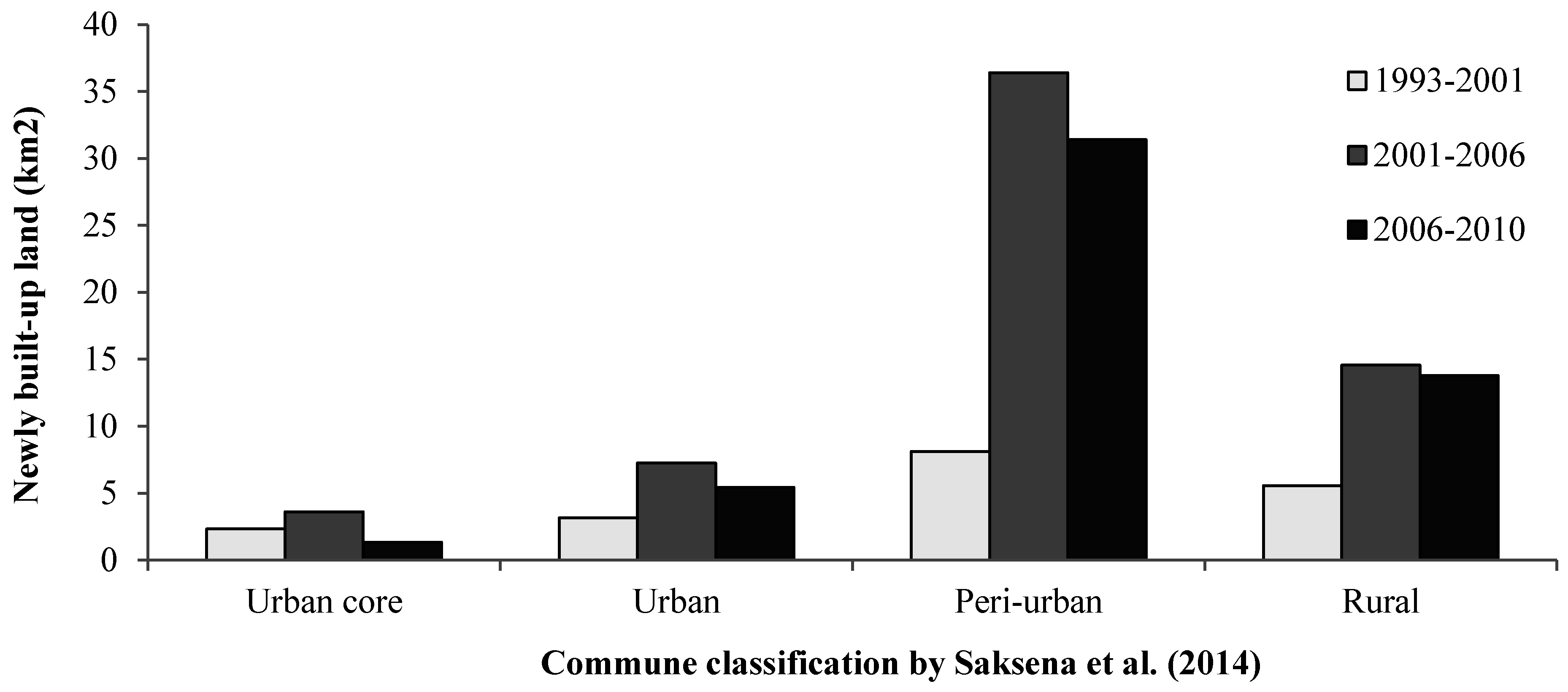
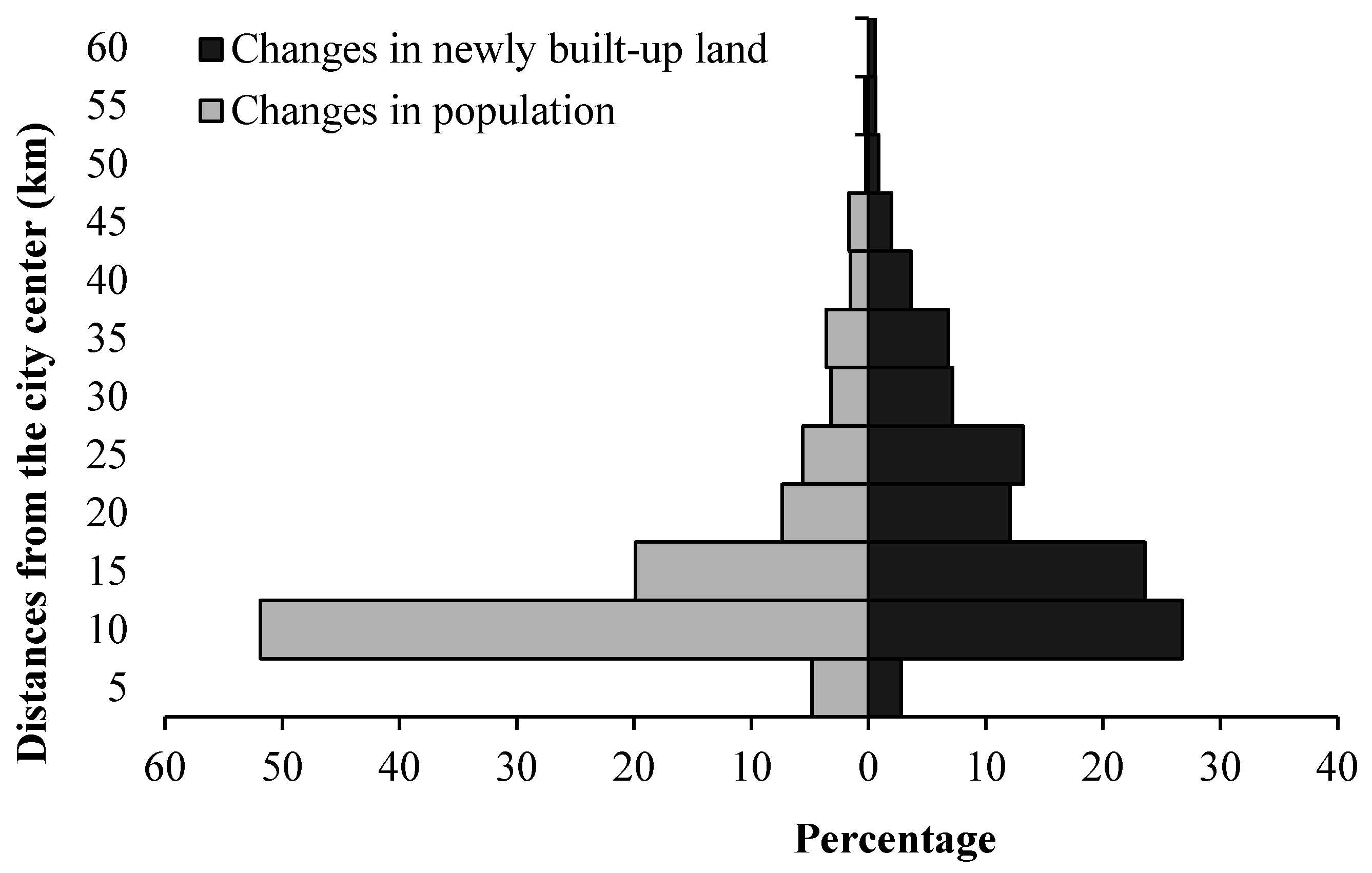

4.3. Policy Implication
5. Conclusions
Acknowledgments
Author Contributions
Conflicts of Interest
References
- ADB. Sustainable Urbanization in Asia and Latin America; Publication Stock No. BKK146703–2; Asian Development Bank: Mandaluyong City, Philippines, 2014. [Google Scholar]
- Welle-Strand, A.; Vlaicu, M.; Tjeldvoll, A. Vietnam—A new economic dragon in southeast Asia? J. Developing Societies 2013, 29, 155–187. [Google Scholar] [CrossRef]
- The 2009 Vietnam Population and Housing census: Major Findings; Central Population and Housing Census, Steering Committee: Hanoi, Vietnam, 2010.
- Campbell, T. A Tale of Two Cities in Vietnam; World Bank: Washington, DC, USA, 1999. [Google Scholar]
- Vietnam Urbanization Review: Technical Assistance Report; World Bank: Wasington, DC, USA, 2011; p. 238.
- Labbé, D. Facing the Urban Transition in Hanoi: Recent Urban Planning Issues and Initiatives; Institut national de la recherche scientifique, Centre Urbanisation, culture et société: Quebec, QC, Canada, 2010. [Google Scholar]
- Biau, D. Vietnam Urban Planning and Development Association. Avaliable online: http://ashui.com/mag/vupda (accessed on 15 April 2015).
- Duong, N.; Thoa, L.; Hoan, N.; Taun, T.; Thu, H.; Seto, K. A study on urban growth of Hanoi using multi-temporal and multi-sensor remote sensing data. Asian J. Geoinf. 2003, 3, 69–72. [Google Scholar]
- Luan, T.D. Living in “new urban areas”: Towards sustainable urban communities in Hanoi, Vietnam. In Environmental Impact II; WIT Press: Southampton, UK, 2014; Volume 181, pp. 333–344. [Google Scholar]
- Douglas, R. On the Edge: Shaping the Future of Peri-Urban East Asia; Institute of International Studies, Stanford University: Stanford, CA, USA, 2002. [Google Scholar]
- Pham, M.H.; Yamaguchi, Y. Monitoring land cover change of the Hanoi city center under impacts of urbanization by using remote sensing. In Proceedings of International Symposium on Geoinformatics for Spatial Infrastructure Development in Earth and Allied Sciences, Ho Chi Minh, Vietnam, 9–11 November 2006.
- Pham, H.M.; Yamaguchi, Y. Urban growth and change analysis using remote sensing and spatial metrics from 1975 to 2003 for Hanoi, Vietnam. Int. J. Remote Sens. 2011, 32, 1901–1915. [Google Scholar] [CrossRef]
- Pham, H.M.; Yamaguchi, Y.; Bui, T.Q. A case study on the relation between city planning and urban growth using remote sensing and spatial metrics. Landsc. Urban Plann. 2011, 100, 223–230. [Google Scholar] [CrossRef]
- Duong, N.D.; Le Kim Thoa, N.T.H.; Tuan, T.A.; Le Thu, H. Study on urban growth of Hanoi using multitemporal and multisensor remote sensing data. In Proceedings of International Symposium on Geoinformatics for Spatial Infrastructure Development in Earth and Allied Sciences, Hanoi, Vietnam, 25–28 September 2002.
- Schneider, A.; Woodcock, C.E. Compact, dispersed, fragmented, extensive? A comparison of urban growth in twenty-five global cities using remotely sensed data, pattern metrics and census information. Urban Stud. 2008, 45, 659–692. [Google Scholar] [CrossRef]
- Duan, H.D.; Shibayama, M. Studies on Hanoi urban transition in the late 20th century based on GIS/RS. Southeast Asian Stud. 2009, 46, 532–546. [Google Scholar]
- Castrence, M.; Nong, D.; Tran, C.; Young, L.; Fox, J. Mapping urban transitions using multi-temporal Landsat and DMSP-OLS night-time lights imagery of the Red River Delta in Vietnam. Land 2014, 3, 148–166. [Google Scholar] [CrossRef]
- Saksena, S.; Fox, J.; Spencer, J.; Castrence, M.; DiGregorio, M.; Epprecht, M.; Sultana, N.; Finucane, M.; Nguyen, L.; Vien, T. Classifying and mapping the urban transition in Vietnam. Appl. Geogr. 2014, 50, 80–89. [Google Scholar] [CrossRef]
- Vien, T.D.; Quang, N.V.; Van Dung, N. Rural-Urban Land Use Changes in Peri-Urban Hanoi; Hanoi, The Hague: Hanoi Agricultural University and Wageningen University and Research Centre: Hanoi, Vietnam, 2005. [Google Scholar]
- Logan, W.S. Hanoi: Biography of A City; UNSW Press: Sydney, Australia, 2000. [Google Scholar]
- HSO. Hanoi Statistical Yearbook 2008; Hanoi Statistical Office: Hanoi, Vietnam, 2009. [Google Scholar]
- Vietnam News Agency. Available online: http://vietnamnews.vn/economy/260399/ha-noi-seeks-to-attract-more-foreign-high-tech-investment.html (accessed on 20 January 2015).
- Van Suu, N. Agricultural land conversion and its effects on farmers in contemporary Vietnam. Focaal 2009, 2009, 106–113. [Google Scholar] [CrossRef]
- Boothroyd, P.; Phạm, X.N. Socioeconomic Renovation in Vietnam: The Origin, Evolution, and Impact of Doi Moi; IDRC: Ottawa, ON, Canada, 2000. [Google Scholar]
- Myint, S.W.; Lam, N. Examining lacunarity approaches in comparison with fractal and spatial autocorrelation techniques for urban mapping. Photogramm. Eng. Remote Sens. 2005, 71, 927–937. [Google Scholar] [CrossRef]
- Yang, X. Urban Remote Sensing: Monitoring, Synthesis and Modeling in the Urban Environment; John Wiley & Sons: Chichester, UK, 2011. [Google Scholar]
- Kontgis, C.; Schneider, A.; Fox, J.; Saksena, S.; Spencer, J.H.; Castrence, M. Monitoring peri-urbanization in the greater Ho Chi Minh city metropolitan area. Appl. Geogr. 2014, 53, 377–388. [Google Scholar] [CrossRef]
- Griffiths, P.; Hostert, P.; Gruebner, O.; van der Linden, S. Mapping megacity growth with multi-sensor data. Remote Sens. Environ. 2010, 114, 426–439. [Google Scholar] [CrossRef]
- Wulder, M.A.; White, J.C.; Goward, S.N.; Masek, J.G.; Irons, J.R.; Herold, M.; Cohen, W.B.; Loveland, T.R.; Woodcock, C.E. Landsat continuity: Issues and opportunities for land cover monitoring. Remote Sens. Environ. 2008, 112, 955–969. [Google Scholar] [CrossRef]
- Hilker, T.; Wulder, M.A.; Coops, N.C.; Seitz, N.; White, J.C.; Gao, F.; Masek, J.G.; Stenhouse, G. Generation of dense time series synthetic landsat data through data blending with modis using a spatial and temporal adaptive reflectance fusion model. Remote Sens. Environ. 2009, 113, 1988–1999. [Google Scholar] [CrossRef]
- Huang, C.; Goward, S.N.; Masek, J.G.; Thomas, N.; Zhu, Z.; Vogelmann, J.E. An automated approach for reconstructing recent forest disturbance history using dense landsat time series stacks. Remote Sens. Environ. 2010, 114, 183–198. [Google Scholar] [CrossRef]
- Kennedy, R.E.; Cohen, W.B.; Schroeder, T.A. Trajectory-based change detection for automated characterization of forest disturbance dynamics. Remote Sens. Environ. 2007, 110, 370–386. [Google Scholar] [CrossRef]
- Verbesselt, J.; Hyndman, R.; Newnham, G.; Culvenor, D. Detecting trend and seasonal changes in satellite image time series. Remote Sens. Environ. 2010, 114, 106–115. [Google Scholar] [CrossRef]
- Schneider, A. Monitoring land cover change in urban and peri-urban areas using dense time stacks of landsat satellite data and a data mining approach. Remote Sens. Environ. 2012, 124, 689–704. [Google Scholar] [CrossRef]
- Song, C.; Woodcock, C.E.; Seto, K.C.; Lenney, M.P.; Macomber, S.A. Classification and change detection using Landsat TM data: When and how to correct atmospheric effects? Remote Sens. Environ. 2001, 75, 230–244. [Google Scholar] [CrossRef]
- Mountrakis, G.; Im, J.; Ogole, C. Support vector machines in remote sensing: A review. ISPRS J. Photogramm. Remote Sens. 2011, 66, 247–259. [Google Scholar] [CrossRef]
- Huang, C.; Goward, S.N.; Schleeweis, K.; Thomas, N.; Masek, J.G.; Zhu, Z. Dynamics of national forests assessed using the landsat record: Case studies in eastern united states. Remote Sens. Environ. 2009, 113, 1430–1442. [Google Scholar] [CrossRef]
- Esch, T.; Himmler, V.; Schorcht, G.; Thiel, M.; Wehrmann, T.; Bachofer, F.; Conrad, C.; Schmidt, M.; Dech, S. Large-area assessment of impervious surface based on integrated analysis of single-date landsat-7 images and geospatial vector data. Remote Sens. Environ. 2009, 113, 1678–1690. [Google Scholar] [CrossRef]
- Kavzoglu, T.; Colkesen, I. A kernel functions analysis for support vector machines for land cover classification. Int. J. Appl. Earth Obs. Geoinf. 2009, 11, 352–359. [Google Scholar] [CrossRef]
- Carrão, H.; Gonçalves, P.; Caetano, M. Contribution of multispectral and multitemporal information from modis images to land cover classification. Remote Sens. Environ. 2008, 112, 986–997. [Google Scholar] [CrossRef]
- Li, D.-C.; Liu, C.-W. A class possibility based kernel to increase classification accuracy for small data sets using support vector machines. Expert Syst. Appl. 2010, 37, 3104–3110. [Google Scholar] [CrossRef]
- Huang, C.; Song, K.; Kim, S.; Townshend, J.R.; Davis, P.; Masek, J.G.; Goward, S.N. Use of a dark object concept and support vector machines to automate forest cover change analysis. Remote Sens. Environ. 2008, 112, 970–985. [Google Scholar] [CrossRef]
- Petropoulos, G.P.; Kontoes, C.; Keramitsoglou, I. Burnt area delineation from a uni-temporal perspective based on landsat tm imagery classification using support vector machines. Int. J. Appl. Earth Obs. Geoinf. 2011, 13, 70–80. [Google Scholar] [CrossRef]
- Steele, B.M. Maximum posterior probability estimators of map accuracy. Remote Sens. Environ. 2005, 99, 254–270. [Google Scholar] [CrossRef]
- Congalton, R.G.; Green, K. Assessing the Accuracy of Remotely Sensed Data: Principles and Practices; CRC Press: Boca Raton, FL, USA, 2008. [Google Scholar]
- Fung, T.; So, L.; Chen, Y.; Shi, P.; Wang, J. Analysis of green space in chongqing and nanjing, cities of china with ASTER images using object-oriented image classification and landscape metric analysis. Int. J. Remote Sens. 2008, 29, 7159–7180. [Google Scholar] [CrossRef]
- Kroll, F.; Müller, F.; Haase, D.; Fohrer, N. Rural–urban gradient analysis of ecosystem services supply and demand dynamics. Land Use Policy 2012, 29, 521–535. [Google Scholar] [CrossRef]
- Pillsbury, F.C.; Miller, J.R. Habitat and landscape characteristics underlying anuran community structure along an urban-rural gradient. Ecol. Appl. 2008, 18, 1107–1118. [Google Scholar] [CrossRef] [PubMed]
- Sadler, J.; Small, E.; Fiszpan, H.; Telfer, M.; Niemelä, J. Investigating environmental variation and landscape characteristics of an urban–rural gradient using woodland carabid assemblages. J. Biogeogr. 2006, 33, 1126–1138. [Google Scholar] [CrossRef]
- Hahs, A.K.; McDonnell, M.J. Selecting independent measures to quantify melbourne’s urban–rural gradient. Landsc. Urban Plann. 2006, 78, 435–448. [Google Scholar] [CrossRef]
- Hunt, S.D.; Guzy, J.C.; Price, S.J.; Halstead, B.J.; Eskew, E.A.; Dorcas, M.E. Responses of riparian reptile communities to damming and urbanization. Biol. Conserv. 2013, 157, 277–284. [Google Scholar] [CrossRef]
- Lockaby, B.; Zhang, D.; McDaniel, J.; Tian, H.; Pan, S. Interdisciplinary research at the urban–rural interface: The west GA project. Urban Ecosyst. 2005, 8, 7–21. [Google Scholar] [CrossRef]
- Luck, M.; Wu, J. A gradient analysis of urban landscape pattern: A case study from the Phoenix metropolitan region, Arizona, USA. Landsc. Ecol. 2002, 17, 327–339. [Google Scholar] [CrossRef]
- Williams, N.S.; McDonnell, M.J.; Seager, E.J. Factors influencing the loss of an endangered ecosystem in an urbanising landscape: A case study of native grasslands from Melbourne, Australia. Landsc. Urban Plann. 2005, 71, 35–49. [Google Scholar] [CrossRef]
- Chen, F.; Ye, H.; Zhao, X. Making Use of the Landsat 7 SLC-OFF ETM+ Image Through Different Recovering Approaches; INTECH Open Access Publisher: Rijeka, Croatia, 2012. [Google Scholar]
- Maxwell, S. Filling Landsat ETM+ SLC-OFF gaps using a segmentation model approach. Photogramm. Eng. Remote Sens. 2004, 70, 1109–1112. [Google Scholar]
- Zhang, C.; Li, W.; Travis, D. Gaps-fill of SLC-OFF Landsat ETM+ satellite image using a geostatistical approach. Int. J. Remote Sens. 2007, 28, 5103–5122. [Google Scholar] [CrossRef]
- Corbould, C. Feeding the Cities: Is Urban Agriculture the Future of Food Security? Stragegic Analysis Paper. Future Directions International. Available online: http://futuredirections.org.au (accessed on 27 April 2015).
- Pham, V.C.; Pham, T.-T.-H.; Tong, T.H.A.; Nguyen, T.T.H.; Pham, N.H. The conversion of agricultural land in the peri-urban areas of Hanoi (Vietnam): Patterns in space and time. J. Land Use Sci. 2015, 10, 224–242. [Google Scholar] [CrossRef]
- An, L.Q. Agriculture and development: Toward a sustainable agriculture in Vietnam. In Vietnam and IRRI: A Partnership in Rice Research: Proceedings of a Conference held in Hanoi, Vietnam, 4–7 May 1994; Int. Rice Res. Inst.: Los Banos, Philippines, 1995; pp. 45–46. [Google Scholar]
- Tacoli, C. International Institute for Environment and Development. Avaliable online: http://www.iied.org/stopping-rural-people-going-cities-only-makes-poverty-less-visible-stripping-migrants-rights-makes (accessed on 5 May 2015).
- Linh, T.G.; Thao, N.T.P. Social Protection for Rural-Urban Migrants in Vietnam: Current Situation, Challenges and Opportunities; CSP Research Report 08; Centre for Social Protection: Brighton, UK, 2011. [Google Scholar]
- Straubhaar, T.; Vâdean, F.P. International migrant remittances and their role in development. In Migration, Remittances and Development; OECD: Paris, France, 2005; pp. 13–37. [Google Scholar]
- Thao, V.T. Making a living in rural Vietnam from (IM) mobile livelihoods: A case of women’s migration. Popul. Space Place 2013, 19, 87–102. [Google Scholar] [CrossRef]
© 2015 by the authors; licensee MDPI, Basel, Switzerland. This article is an open access article distributed under the terms and conditions of the Creative Commons Attribution license (http://creativecommons.org/licenses/by/4.0/).
Share and Cite
Nong, D.H.; Fox, J.; Miura, T.; Saksena, S. Built-up Area Change Analysis in Hanoi Using Support Vector Machine Classification of Landsat Multi-Temporal Image Stacks and Population Data. Land 2015, 4, 1213-1231. https://doi.org/10.3390/land4041213
Nong DH, Fox J, Miura T, Saksena S. Built-up Area Change Analysis in Hanoi Using Support Vector Machine Classification of Landsat Multi-Temporal Image Stacks and Population Data. Land. 2015; 4(4):1213-1231. https://doi.org/10.3390/land4041213
Chicago/Turabian StyleNong, Duong H., Jefferson Fox, Tomoaki Miura, and Sumeet Saksena. 2015. "Built-up Area Change Analysis in Hanoi Using Support Vector Machine Classification of Landsat Multi-Temporal Image Stacks and Population Data" Land 4, no. 4: 1213-1231. https://doi.org/10.3390/land4041213






